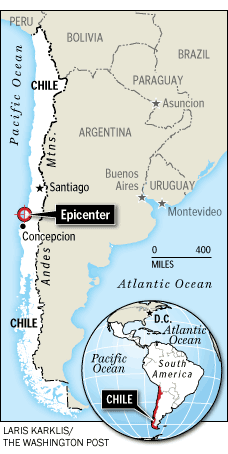
8.8-magnitude earthquake hits central Chile; tsunami warnings issued for Hawaii, Australia, South America (with slide show)
Jonathan Franklin and Mary Beth Sheridan Washington Post Staff Writers
The magnitude-8.8 quake was the worst in Chile in half a century. As the earth heaved, bridges buckled, homes collapsed into piles of bricks and cars flipped over. In Concepcion, a southern city near the epicenter, explosions rocked the main university as vials of laboratory chemicals shattered and ignited a building.

Within hours of the quake, the entire Pacific rim, from Japan to Australia, was on tsunami alert. A set of turbulent and destructive waves topping out at six feet and moving at high speed are expected to reach Hawaii about 11:05 a.m. local time (4:05 p.m. EST).
"Six feet is a lot. Tsunamis have a lot of force behind them," Jenifer Rhoades, Tsunami Program Manager for the National Weather Service.
At 6 a.m. local time, sirens wailed on the Hawaiian coast alerting people to tune into television and radio stations for instructions. Those living in areas susceptible to the tsunami will be instructed to evacuate, said Shelly Ichishita, a spokeswoman for the state Department of Civil Defense.
A tsunami advisory -- less urgent than a warning -- has been posted for the U.S. and Canadian west coast and coastal Alaska, Rhoades said. Although there may not be large waves there, the currents can become dangerous, she said.
In Chile, the most dramatic scenes were around Concepcion, the country's second-largest city, where an estimated 130 people were trapped inside a new 14-story building that collapsed.
The 3:34 a.m. quake churned up huge waves that smashed into the coast. One of them swept away the police station and a craft market in the village of Iloca, where residents fled to the hills.
Santiago, about 200 miles northeast of the epicenter, was enveloped Saturday in a gray cloud of dust and smoke from fires. Highway overpasses, billboards and the roofs of many buildings collapsed, filling the streets with debris. Cracks zigzagged across major roads, widening into holes large enough to swallow up a motorcycle.
In the Maipu neighborhood of the capital, a four-story apartment complex caved into the underground parking lot, crushing the cars. But rescuers managed to pull residents from the rubble.
Roberto Aviles was in his car when the quake occurred shortly after 3 a.m.
"I was sleeping in my taxi and thought that 20 people were shaking my car, it felt like they were going to turn it over," he said.
Elliott Yamin, the "American Idol" star, was tweeting in his hotel room in the Chilean beach resort of Vina del Mar, about 90 miles from the quake epicenter, when the building began to shake.
"That's when I stood up and kind of headed toward my doorway, and opened my door . . . I was yelling, 'Earthquake, earthquake, get out!' " he told CNN.
He and another guest raced down the hallway as the building lurched, with pictures crashing to the floor and lights flickering. "It was like a movie," he said.
The earthquake was far stronger than a 7.0 magnitude temblor that devastated Haiti's capital last month, killing over 200,000 people. But buildings are generally better constructed in Chile to withstand earthquakes. Still, President-elect Sebastian Piñera said the death toll of 122 was likely to rise as reports trickled in from outlying areas where phone lines wern't working.
In Washington, press secretary Robert Gibbs said the White House was "closely monitoring the situation, including the potential for a tsunami. Our thoughts and prayers are with the people of Chile, and we stand ready to help in this hour of need."
The State Department said it was prepared to help Chile "as rapidly and effectively as we can." The U.S. government has activated a disaster response team and put two search-and-rescue teams on alert, spokesman P.J. Crowley said in a statement.
Piñera said the quake had been "a very serious blow to the infrastructure of our country."
One example of that: an enormous bridge over the picturesque Rio Claro collapsed, leaving a lone support pillar and a stretch of freeway that ended abruptly, yawning over highway debris that spilled into the river.
Sports utility vehicles tilted at the edge of one fallen stretch of freeway, with overturned cars and trucks were flung across twisted overpasses. The ground was riven with long foot-wide cracks in the earth.
Santiago's airport was shut down, and director Eduardo del Canto told Chilean television the passenger terminal had been heavily damaged, according to The Associated Press.
About 3 million people were subjected to extreme shaking during the quake, and another 12 million to very strong shaking, according to officials at the U.S. Geological Service.
In Hawaii, the state's emergency response system was activated. All crews aboard vessels and on the ground in state ports were ordered to evacuate, Ichishita said.
"The evacuation zones are predesignated in telephone books. We have maps and predesignated tsunami zones," Ichishita said. "It's based on historical data showing they are susceptible to tsunamis."
Franklin reported from Santiago. Washington Post staff writers Sheridan, Joel Achenbach, Rob Stein and Spencer Hsu in Washington contributed to this report, as did special correspondent Anne-Marie O'Connor in Mexico City
VIEW SLIDE SHOW
http://www.washingtonpost.com/wp-dyn/content/article/2010/02/27/AR2010022700229.html?hpid=topnews
Feb. 27, 2010
